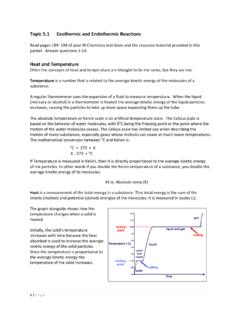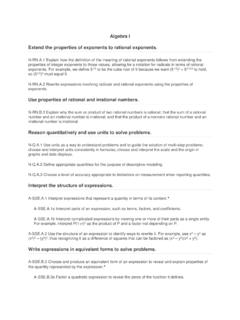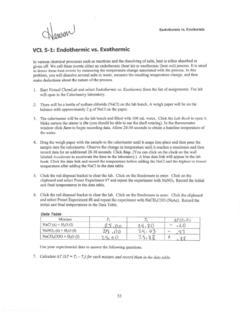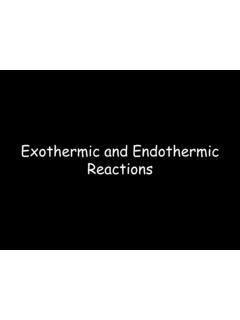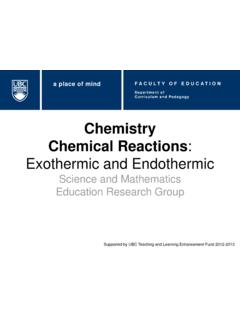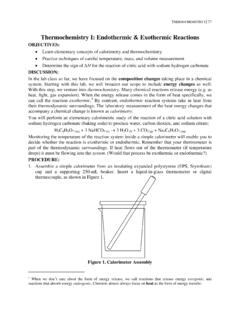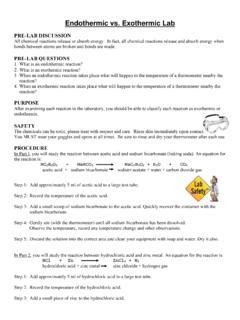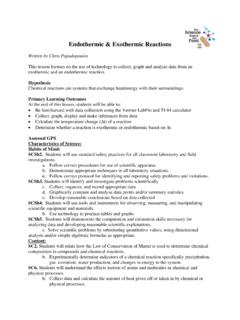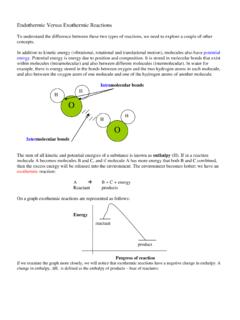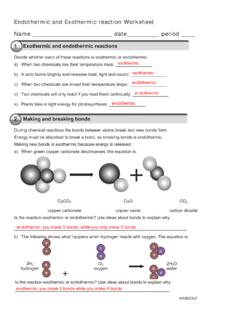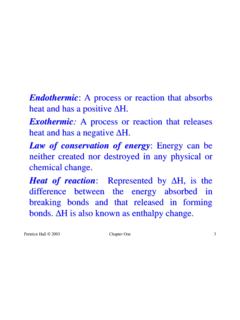Transcription of Topic 5.1 Exothermic and Endothermic Reactions Heat and ...
1 1 | P a g e Topic Exothermic and Endothermic Reactions Read pages 189- 194 of your IB Chemistry text book and the resource material provided in this packet. Answer questions 1-14. heat and Temperature Often the concepts of heat and temperature are thought to be the same, but they are not. Temperature is a number that is related to the average kinetic energy of the molecules of a substance. A regular thermometer uses the expansion of a fluid to measure temperature. When the liquid (mercury or alcohol) in a thermometer is heated the average kinetic energy of the liquid particles increases, causing the particles to take up more space expanding them up the tube. The absolute temperature or Kelvin scale is an artificial temperature scale. The Celsius scale is based on the behavior of water molecules, with 0oC being the freezing point or the point where the motion of the water molecules ceases.
2 The Celsius scale has limited use when describing the motion of many substances, especially gases whose motions can cease at much lower temperatures. The mathematical conversion between oC and Kelvin is: C + 273 = K K -273 = C If Temperature is measured in Kelvin, then it is directly proportional to the average kinetic energy of the particles. In other words if you double the Kelvin temperature of a substance, you double the average kinetic energy of its molecules. KE Absolute temp (K) heat is a measurement of the total energy in a substance. That total energy is the sum of the kinetic (motion) and potential (stored) energies of the molecules. It is measured in Joules (J). The graph alongside shows how the temperature changes when a solid is heated. Initially, the solid s temperature increases with time because the heat absorbed is used to increase the average kinetic energy of the solid particles.
3 Since the temperature is proportional to the average kinetic energy the temperature of the solid increases. 2 | P a g e When the solid is at it melting point, it is changing state from a solid to a liquid. The heat energy is still being absorbed but is not used to increase the average kinetic energy but to increase the chemical potential energy stored in the bonds, causing them to vibrate and break. Because the average kinetic energy of the particles does not increase, the temperature does not change. The same thing happens when a liquid is at its boiling point, the temperature at which it changes state from a liquid to a gas. So, when heat energy is absorbed by a substance, the energy can be used to increase the average kinetic energy of the molecules, causing an increase in temperature. Alternatively the energy can be used to increase the potential energy of the molecules causing a change in state that is not accompanied by an increase in temperature.
4 Since heat is a measure of the total energy of a substance the amount of heat depends on the moles of the substance present. 3 | P a g e Exothermic and Endothermic Reactions When a chemical reaction happens, there can be a net transfer of energy from the reactants into the surroundings ( air, water is in solution) or a net transfer of energy from the surroundings to the reactants causing a change in average kinetic energy of the particles in the surrounding and a proportional change in the temperature. Exothermic Reactions In these Reactions energy is transferred from the reaction system into the surroundings. The average kinetic energy of the surroundings increases causing the reaction mixture to increase in temperature and get warmer. Some examples of Exothermic Reactions are: Burning ( combustion) Neutralization Reactions between acids and alkalis The reaction between water and calcium oxide Endothermic Reactions In these Reactions energy is absorbed from the surroundings.
5 The average kinetic energy of the surrounding decreases causing the reaction mixture to get colder. Some examples of Endothermic Reactions are: the reaction between barium hydroxide and ammonium chloride the reaction between ethanoic acid and sodium carbonate Exothermic and Endothermic Reactions are used extensively in everyday life and in industry. Airbags, a safety device in modern cars, utilize an Exothermic reaction. An Exothermic reaction is responsible for the inflation of air bags in cars. Simulation showing the energy changes associated with dissolving different ionic salts in water Cold and Hot packs used to treat muscular injury involve an Endothermic reaction. 4 | P a g e Endothermic Changes (Reactants absorb heat energy from the surroundings for the change. Average kinetic energy of particles increases) Exothermic Changes (Reactants release heat energy into the surroundings for the change.)
6 Average kinetic energy of particles decreases) ice melting ( s l ) combustion (burning in O2) CH4 + 2 O2 CO2 + 2 H2O photosynthesis respiration Evaporation ( l g ) metal + acid salt + hydrogen Mg(s) + 2 HCl(aq) MgCl2(aq) + H2(g) Melting ( s l ) Acid dissolving in water H2SO4(l) + H2O(l) 2H+(aq) + SO42-(aq) Boiling ( l g ) Condensation (g l ) Bond breaking Bond making Ammonium nitrate dissolving NH4NO3(s) + H2O(l) NH4+(aq) + NO3-aq) Sodium hydroxide dissolving in water NaOH(s) + H2O(l) Na+(aq) + OH-(aq) Decomposition Reactions H2O(g) H2(g) + O2(g) Neutralization Reactions (acid + base salt + water) HCl(aq) + NaOH(aq) NaCl(aq) + H2O(g) N2O(g) N2(g) + O2(g) CaCO3(s) CaO(s) + CO2(g) Forming an ionic solid from gaseous ions Na+(g) + Cl-(g) NaCl(s) Sublimation ( s g ) I2(s) I2(g) Freezing / solidification ( l s ) Ionization Na(g) Na+(g) + e- Calcium chloride dissolving in water CaCl2(s) + + H2O(l) Ca2+(aq) + 2Cl-(aq) Magnesium sulphate dissolving in water MgSO4(s) + + H2O(l) Mg2+(aq) + SO42-(aq) 5 | P a g e Increase in kinetic energy - energy absorbed - Endothermic Decrease in kinetic energy - energy released Exothermic Energy level diagrams Chemical Potential Energy The chemical potential energy stored in the bonds gives us a measure of a substances energy level.
7 The higher the energy, the more chemical energy is stored in its bonds. The reactants and products in a chemical reaction usually have different energy levels, which are shown in a energy level diagram. The vertical axis on this diagram represents the energy level and the horizontal axis represents the progress of the reaction from reactants to products. Energy level diagrams for Exothermic Reactions In an Exothermic reaction, reactants have more energy than the products. The difference between these two energy levels is the energy released to the surroundings, shown as a vertical drop from a higher to a lower level. Because the reactants have more energy than the products they are less stable. 6 | P a g e Usually some extra energy is needed to get the reaction to start. The minimum amount of energy that needs to be absorbed in order for the reactants to be converted into products is called the activation energy.
8 It is drawn in energy level diagrams as a hump. Catalysts reduce the activation energy needed for a reaction to happen - this lower activation energy is shown by the dotted red line in the diagram here. Energy level diagrams for Endothermic Reactions In Endothermic Reactions the reactants have a less energy than the products. The difference between these two energy levels is the energy absorbed from the surroundings. It is represented in an energy level diagram as a vertical jump from a lower to a higher level - the bigger the difference, the more energy is gained. Because the reactants have less energy than the products they are more stable. Questions 1. Define the terms Exothermic and Endothermic reaction. 2. Distinguish between heat and temperature. 3. Classify each of the following Reactions as either Exothermic or Endothermic . a) 2H2O(l) + heat 2H2(g) + O2(g) b) Mg(s) + Cl2(g) MgCl2(s) + heat 4.
9 The complete combustion of acetic acid (HC2H3O2) in oxygen gas to form water and carbon dioxide at constant pressure releases kJ of heat per mole of acetic acid. a) Write a balanced chemical equation for this reaction. b) How much heat (kJ) would be released if you burned moles of acetic acid? c) Draw an energy level diagram for the reaction. 5. Draw an energy level diagram for a reaction in which the total energy of the reactants is 50 kJ mol-1, the total energy of products is 120 kJ mol-1 and the activation energy for the forward reaction is 120 kJ mol-1. Label the diagram clearly. Is this reaction Exothermic or Endothermic ? 7 | P a g e 6. When solid sodium hydroxide is dissolved in water, the temperature of the solution formed rapidly increases. a) Compare the total energy of the solid NaOH with that of the solution and state which is greater. b) Classify this reaction as Endothermic or Exothermic .
10 7. Consider the reaction A + 2B C In this reaction, the total energy of the reactants is 80 kJ mol-1, the total energy of the products is -90 kJmol-1 and the activation energy for the forward reaction is 120 kJ mol-1. a) Draw a diagram of the energy profile for this reaction. Label the diagram. b) State whether the reaction is Endothermic or Exothermic . c) Calculate the energy difference between the reactants and the products. d) Deduce the sign of the enthalpy change. e) Identify with a reason, which is more stable, the reactants of products. 8. (N04/S/2) a) State why enthalpies of combustion Reactions are negative. [1] b) Define activation energy / enthalpy. [1] c) Draw a labeled enthalpy level diagram for an Exothermic and Endothermic reaction showing the activation energy, Ea and enthalpy change. [4] 9. (M05/S/2) In a neutralization reaction 50 cm3 of a moldm-3 solution of sodium hydroxide is mixed rapidly in a glass beaker with 50 cm3 of a moldm-3 solution of sulfuric acid.
